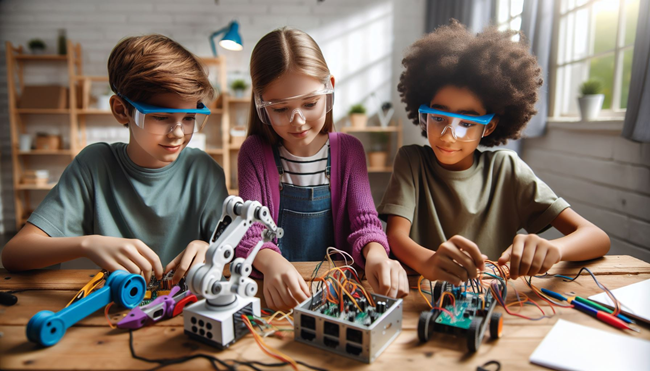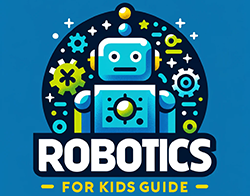Robotics has steadily gained recognition as a pivotal educational tool, equipping the next generation with the skills necessary for careers in engineering and technology. With a blend of creativity, critical thinking, and problem-solving, robotics for kids isn’t just about building robots; it’s about nurturing future innovators. In this guide, we delve into how robotics programs and kits are preparing children for a technologically advanced future, while addressing common questions that parents and educators might have.
What is Robotics for Kids?
Robotics for kids introduces young learners to the concepts of science, technology, engineering, and mathematics (STEM) through the building and programming of robots. This field offers children a hands-on approach to learning, allowing them to engage directly with both the theoretical and practical applications of robotics. By integrating these educational aspects, robotics programs foster an environment where children can develop their skills in a fun and interactive way.

How Does Robotics Prepare Children for Future Careers in Engineering?
Robotics programs provide foundational knowledge and skills that are essential in engineering and technology fields. These programs teach children how to think like engineers — starting with an idea, moving through the design process, and finally, creating and testing a functional robot.
- Problem-Solving Skills: Robotics challenges children to solve problems using logical and creative solutions, which is a core skill in engineering.
- Technical Proficiency: Kids learn programming and mechanical design, which are crucial skills in many tech-driven industries.
- Innovation: As they build and program robots, children learn to innovate and improve on existing technologies, a valuable trait in any engineering field.
- Team Collaboration: Robotics often requires working in teams, helping children to develop strong cooperation and communication skills.
Why is Early Exposure to Robotics Crucial in Child Development?
Early exposure to robotics is essential in child development for several compelling reasons. Integrating robotics into early education not only sparks interest in STEM fields but also cultivates a set of skills that are crucial in the modern world. Here’s a deeper look into the significant benefits:
- Foundation for Complex Problem-Solving: Robotics introduces young learners to complex problem-solving at an early age. When children interact with robots, they are often tasked with missions or projects that require them to think critically and devise solutions. This early problem-solving stimulates their cognitive development, enhancing their ability to understand and process information as they grow.
- Development of Computational Thinking: Computational thinking involves understanding a problem and expressing its solutions in ways that a computer could execute. Through robotics, children learn to break down large problems into manageable parts, recognize patterns, and generate algorithms to solve these problems. These skills are fundamental in computer programming and critical for various technological and engineering challenges.
- Boosts Creativity and Innovation: Robotics is a powerful tool for creativity. Building and programming robots provides children with the opportunity to experiment and implement their ideas in tangible forms. This process not only brings their imagination to life but also encourages them to innovate, a key component in any creative or scientific endeavor.
- Enhances Persistence and Resilience: Learning robotics involves a lot of trial and error. Projects seldom work perfectly on the first try, which teaches children the importance of persistence and resilience. By experiencing failure and learning to troubleshoot issues, children develop the determination needed to overcome obstacles and achieve their goals.
- Improves Social and Teamwork Skills: Many robotics activities are designed for group participation, where children work in teams to build and program robots. This environment teaches them how to communicate effectively, collaborate with peers, and lead projects. These social skills are invaluable throughout school and beyond, as teamwork is a crucial component of most professional fields.
- Prepares for Future Academic and Career Success: With technology becoming integral to nearly every industry, having a background in robotics sets children up for success in the digital age. Early exposure to robotics and programming provides a strong foundation for more advanced education in software engineering, robotics, and other tech-related fields.
- Encourages Lifelong Learning: The field of robotics is always evolving, with new technologies and methodologies continually emerging. Children who engage with robotics from an early age learn to adapt to new information and technologies, fostering a mindset of lifelong learning and continuous improvement.
- Promotes Inclusion and Accessibility: Robotics can be tailored to diverse learning needs and styles, making it an inclusive educational tool that can engage a wide range of children, including those with disabilities. It provides practical, hands-on learning that can be more accessible than traditional academic subjects for many students.
Given these benefits, it’s clear why integrating robotics into early childhood education is not merely an enhancement to traditional learning methods but a fundamental shift towards preparing children for a future where technology and automation will play a dominant role in their personal and professional lives. Early exposure to robotics is not just about teaching children how to program or build robots; it’s about shaping adaptable, resilient, and capable individuals who are prepared to lead and innovate in the 21st century.
Top Questions
How do robotics programs enhance children’s learning experiences?
Robotics programs enhance learning by making abstract concepts tangible. Children see firsthand how mathematical equations and scientific principles apply to real-world situations, such as robotics. This application helps solidify their learning and encourages deeper engagement with the material.
What age is appropriate to start learning robotics?
Children as young as five can begin learning robotics using age-appropriate kits that focus more on creativity and simple construction. As children grow, the complexity of the robotics kits can increase to introduce more advanced programming and engineering concepts.
What are the best robotics kits for beginners?
For beginners, robotics kits like LEGO Boost, Botley the Coding Robot, and the Makeblock mBot offer an excellent introduction to robotics. These kits provide simple programming options and sturdy components suitable for younger children.
Can robotics be taught at home?
Yes, many robotics kits are designed for home use, complete with educational resources and online support. Parents can facilitate their children’s learning by providing these tools and spending time building and programming robots together.
What skills do kids develop from participating in robotics?
Robotics helps children develop a range of skills, including but not limited to:
- Technical skills like coding and circuitry
- Soft skills like problem-solving, patience, and persistence
- Interpersonal skills through teamwork and competition
How does participating in robotics influence a child’s future academic and career paths?
Participating in robotics can profoundly influence a child’s academic choices and career path, steering them towards STEM fields. It provides a solid foundation in technical skills and problem-solving abilities highly valued in higher education and the workplace.
Are there any online courses for kids interested in robotics?
Numerous online platforms offer robotics courses for children, ranging from beginner to advanced levels. Websites like Code.org, Khan Academy, and Udemy provide structured courses that cater to various age groups and skill levels.
What are the challenges of integrating robotics into the classroom?
Integrating robotics into the classroom can be challenging due to budget constraints, teacher training, and curriculum integration. However, the benefits often outweigh the challenges, as robotics can enhance the learning experience and provide students with necessary 21st-century skills.
How much does it cost to start a robotics program for kids?
The cost can vary depending on the quality and complexity of the robotics kits and the extent of the program. Basic kits can start from as little as $30, but comprehensive educational programs might require more substantial investment.
What are the future trends in robotics education?
Future trends in robotics education likely include more personalized learning experiences, greater integration of AI, and increased use of virtual and augmented reality. These advancements could make robotics education more accessible and tailored to individual learning styles.



